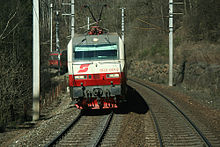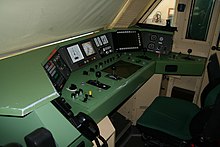ÖBB 1822
| ÖBB 1822 | |
|---|---|
|
1822 003 in the Innsbruck traction
|
|
| Numbering: | 1822 001-005 |
| Number: | 5 |
| Manufacturer: | SGP Graz , ABB (Switzerland), Siemens |
| Year of construction (s): | 1990-1991 |
| Retirement: | 2014– |
| Axis formula : | Bo'Bo ' |
| Length over buffers: | 19,300 mm |
| Bogie axle base: | 2,700 mm |
| Service mass: | 82.0 t |
| Wheel set mass : | 20.5 t |
| Top speed: | 140 km / h |
| Continuous output : | 4,400 kW |
| Starting tractive effort: | 280 kN |
| Performance indicator: | 64.2 kW / t |
| Power system : | 15 kV 16.7 Hz ~ 3 kV = |
| Number of traction motors: | 4 × 6FRA 7059 |
| Drive: | Three-phase asynchronous motors SLM steering slide bearing drive |
| Brake: | electrical resistance brake indirect brake direct compressed air brake spring-loaded brake |
The 1822 series is an electric locomotive of the Austrian Federal Railways . The 1822, known as the Brenner Locomotive, were to be used in multiple units in front of trains on the Rolling Road in order to get a grip on the transit problem over the Brenner Pass . Their main area of use, however, was the corridor trains to Lienz until they were shut down in September 2007.
history
At the urging of ABB , the first ideas to use dual-system locomotives to accelerate the Brenner transit ( Munich - Innsbruck - Verona ) arose as early as 1987 . The then Transport Minister Rudolf Streicher therefore commissioned ÖBB to procure five prototypes that should be usable both in the domestic network (15 kV / 16.7 Hz alternating current ) and in Italy (3 kV direct current ). This idea was seen as trend-setting, but the completion and commissioning of the locomotives built between 1990 and 1991 was delayed for years until the final delivery. After the rolling road over the Brenner Pass was closed in 1992, the ÖBB no longer showed any great interest in the locomotive. The locomotive 1822 003 was taken over in 1993 for formal reasons so that the licensing runs could take place in Italy. The remaining locomotives were not taken over until 1996 after the locomotives had received approval in Italy in October 1995.
SGP Graz supplied the mechanical part, ABB the electrical part. The ÖBB was not interested in further building the 1822 because the FS was not interested in trains passing through. This was only possible with the locomotives of the E.412 series of the FS and the 189 series of the Deutsche Bahn .
The five have been at home in Innsbruck since they were accepted in 1822 . They were rarely used for the originally intended task of hauling freight trains in double traction , but rather in front of the corridor trains from Innsbruck to Lienz and their feeder lines from Innsbruck to Kufstein and from Lienz to Spittal an der Drau .
In 2005, the 1822 002 and 1822 005 were sold to Poland , where they were last owned by DB Schenker Rail Polska and were scrapped in early 2014. The owner no longer had any need for the locomotives, which should have been subjected to a general inspection . With the scrapping, he was able to prevent the locomotives from falling into the hands of a competitor.
The locomotives used in front of the corridor trains were to be replaced by diesel locomotives of the 2016 series . This plan failed, however, because the 2016er suffered technical damage when it was first used. Another obstacle was the train heating system from 2016, which works with a frequency of 50 Hz and would have disrupted the Italian track circuits. After temporarily rented locomotives of the 189 series were used, the multi-system locomotives of the 1216 series took over the corridor trains from summer 2007, so that in September 2007 the remaining three locomotives with the numbers 1822 001, 1822 003 and 1822 004 were parked. They could not be sold to Poland because they were part of a sale-lease-back contract and were therefore stored in Bludenz . In autumn 2010 the locomotives were transferred to the TS plant in Linz, where they were reconditioned, and from December of the same year they were parked in the Wolfurt freight yard .
At the beginning of 2014, the remaining three locomotives were acquired by P&P Eisenbahntechnik, refurbished to operational readiness in Krieglach and leased to the railway company Adria Transport . The machines are to be used from summer 2014 [obsolete] to haul freight trains from the port of Koper to the Czech Republic on the Koper - Vienna route. The 1822 series is particularly suitable for this, as there is an axle load limit of 20 t on the Maribor - Spielfeld route , which is why the 1216 series cannot be used there.
construction
mechanical construction
The main frame and the locomotive body with corrugated side walls are made of welded lightweight steel, as are the two driver's cabs , which are provided with a screwed-on GRP shell. The driver's cabs are accessed from the machine room, which can be entered via a door located on the left behind the driver's cab in the direction of travel. The air-conditioned driver's cabs are spacious and have an undivided windshield . The driver's desk is bilingual in German and Italian .
The engine room has a central aisle. It houses the two power converters with boiler pipe cooling from Siemens , Erlangen , as well as the control technology cabinets and the braking equipment. The control technology corresponds to that of SBB Re 460 . For reasons of space, the transformer was installed under the locomotive frame between the two bogies.
The roof is an aluminum construction consisting of three removable hoods, which gives access to the engine room for the exchange of assemblies. The fans are arranged in the roof slope.
The locomotive body is supported by centering flexicoil springs on the bogies , which correspond to those of the SBB series Re 450 used by the Zurich S-Bahn and the Re 456 used by private railways . They were built in Austria under license from SLM . A modified steering slide bearing drive is used as the drive, which allows radial adjustment of the axles. The gear ratio is 91:22. The power is transmitted from the bogie to the locomotive body by means of low-lying tie rods.
The locomotive is equipped with the usual braking systems for the direct and indirect brakes, a spring-loaded brake serves as a parking brake.
The side walls and the lower part of the front section were painted traffic red, a stripe on the side wall and the upper part of the front section are gray and white. An area around the windows, the roof, the frame and the bogies are painted umbra gray. The almost 1.6 m high ÖBB emblems on the side wall are particularly striking - later the word mark ÖBB was attached to the front at the bottom .
Electric Construction
Compared to the other ÖBB locomotives, the electrical equipment has the additional parts for 3 kV operation and is therefore more complex. In addition to the three single-arm pantographs - one for the ÖBB network (type VII) and two for the FS network (type 52) - the roof also supports the system separator and the 3 kV surge arrester, as well as the roof braking resistors with 1 MW output. The oil-cooled, underfloor arranged transformer supplies the four-quadrant actuator. This was implemented in three-point connection and supplies a DC voltage intermediate circuit of 2 × 1750 V. In DC operation, the contact line voltage, which fluctuates between 2 and 4.2 kV, is fed directly into the intermediate circuit. The GTO thyristors used are cooled in a boiler and conduct the required motor current for the four three-phase squirrel-cage asynchronous motors. Control takes place via the digital control system MICAS-S2. The locomotives are equipped for multiple control of four vehicles and have the usual safety devices of the ÖBB and the FS - in 1998/99 the Italian driver's cab signaling SASIB was also installed.
literature
- Klaus-J. Vetter: The great manual for electric locomotives. Sconto, Munich 2003, ISBN 3-7654-4066-3 .
- Klaus Eckert, Torsten Berndt: Lexicon of the locomotives. Komet Verlag GmbH, Cologne 2005, ISBN 3-89836-505-0 .
- Markus Inderst : Picture atlas of the ÖBB locomotives. All traction vehicles of the Austrian Federal Railways. GeraMond, Munich 2010, ISBN 978-3-7654-7084-4 .
- Francessco Pozzato: The Tyrolean women Le Tirolesi: The locomotives of the 1822 series Le locomotive del gruppo 1822. Athesia Publishing House, Bozen 2011, ISBN 978-88-8266-784-9 .
- Markus Inderst in Lok-Magazin 1/2017, pages 64–73: ÖBB series 1822 - pursued by bad luck. GeraMond, Munich 2017, ISSN 0458-1822 / 10813.
Web links
- Website about the ÖBB 1822 ( Memento from June 6, 2004 in the Internet Archive )
- Pictures from the ÖBB series 1822
Individual evidence
- ↑ a b Technical vehicle portrait ÖBB series 1822. In: Digitales Eisenbahn-Fotoarchiv. Retrieved January 13, 2014 (requires registration).
- ↑ Type sketches of the 1822 series ( Memento of the original from July 14, 2014 in the Internet Archive ) Info: The archive link was automatically inserted and not yet checked. Please check the original and archive link according to the instructions and then remove this notice. (Registration required)
- ↑ PL: 1822 002 and 005, their final hour. Railcolor.net , January 10, 2014, accessed January 13, 2014 .
- ↑ a b c New start for the forgotten series in Austria in 1822 . In: Eisenbahn-Revue . No. 6 , 2014, p. 273-274 .



